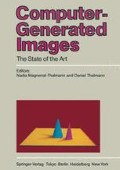Résumé
Différentes mesures de la similarité entre segments sont étudiées pour la segmentation de l’image. Une segmentation agglomerative hiérarchique compare et fusionne deux segments s’ils sont similaires. L’algorithme utilisé fusionne, à chaque itération, les deux segments les plus similaires. Regardant la segmentation de l’image comme un problème d’approximation, la mesure de similarité est reliée à l’erreur totale d’approximation; l’accroissement de l’erreur produit par la fusion de deux segments est utilisé. Une image de télédétection est segmentée par l’approximation de chaque région soit par une constante ou soit par un plan. Une mesure de similarité sensible à la variance locale de l’image est aussi présentée. Les avantages de la combinaison de différentes mesures sont aussi soulignés. Différentes régions d’une image peuvent nécessiter différentes mesures qui doivent donc être combinées pour obtenir, dans l’ensemble, un bon résultat. De plus, dans une segmentation hiérarchique, une mesure simple peut être utilisée lors des premières fusions, tandis que des mesures plus complexes vont être employees par la suite.
Abstract
The problem of defining appropriate segment similarity measures for picture segmentation is exmained. In agglomerative hierqarchical segmentation, two segments are coamapared and merged if found similar. The propesed Hierarchical Step-Wise Optimization (HSWO) algorithm finds and then merges the two most similar segements, on a step-by-step basis. By considering picture segmentation as a piece-wise picture approximation problem, the similarity measure (or the step-wise criterion) is related to the overall approximation error. The measure then corresponds to the increase of the approximation error resulting from merging two segments. Similarity measures derived from constant approximations (zeroth order polynomials) and planar approximations (first order polynomials). An adaptive measurebased upon local variance is also used. The advantages of combining similarity measures (or cirteria) are also stressed. Different picture areas can require different measures which must therefore be combined in order to obtain good overall results. Moreover, in hierarchical segmentation, simple measures can be used for the first merging steps, while, at a higher level of the segment hierarchy, more complex measures can be employed.
Access this chapter
Tax calculation will be finalised at checkout
Purchases are for personal use only
Preview
Unable to display preview. Download preview PDF.
References
Beaulieu JM, Goldberg M (1982) Hierarchical Picture Segmentation by Approximation. Canadian Communication and Enttigy Convenience, Montreal (Canada): 393–396.
Beaulieu JM, Goldberg M (1983) Step-Wise Optimization for Hierarchical Picture Segmentation. Conf. on ComputeVision and atte.fin Recognition, Washington, D.C.: 59–64.
Brice C, Fennema C (1970) Scene Analysis Using Regions. A Intell. 1: 205–226.
Chen PC, Pavlidis T (1980) Image Segmentation as an Estimation Problem. Comput. Graphic image, Pioce,66. 12: 153–172.
Freuder EC (1976) Affinity: A Relative Approach to Region Finding. Comput. Griaphics Image. Piece. 65: 254–264.
Horowitz SL, Pavlidis T (1976) Picture Segmentation by a Tree Traversal Algorithm. JACM 23: 368–388.
Pavlidis T (1979) Hierarchies in Structural Pattern Recognition. Koc. IEEE 67:737–744.
Zobrist AL, Thompson WB (1975) Building a Distance Function for Gestalt Grouping. IEEE trans. Comput C-4: 718–728.
Author information
Authors and Affiliations
Editor information
Editors and Affiliations
Rights and permissions
Copyright information
© 1985 Springer-Verlag Tokyo
About this paper
Cite this paper
Beaulieu, J.M., Goldberg, M. (1985). Selection of Segment Similarity Measures for Hierarchical Picture Segmentation. In: Magnenat-Thalmann, N., Thalmann, D. (eds) Computer-Generated Images. Springer, Tokyo. https://doi.org/10.1007/978-4-431-68033-8_8
Download citation
DOI: https://doi.org/10.1007/978-4-431-68033-8_8
Publisher Name: Springer, Tokyo
Print ISBN: 978-4-431-68035-2
Online ISBN: 978-4-431-68033-8
eBook Packages: Springer Book Archive

